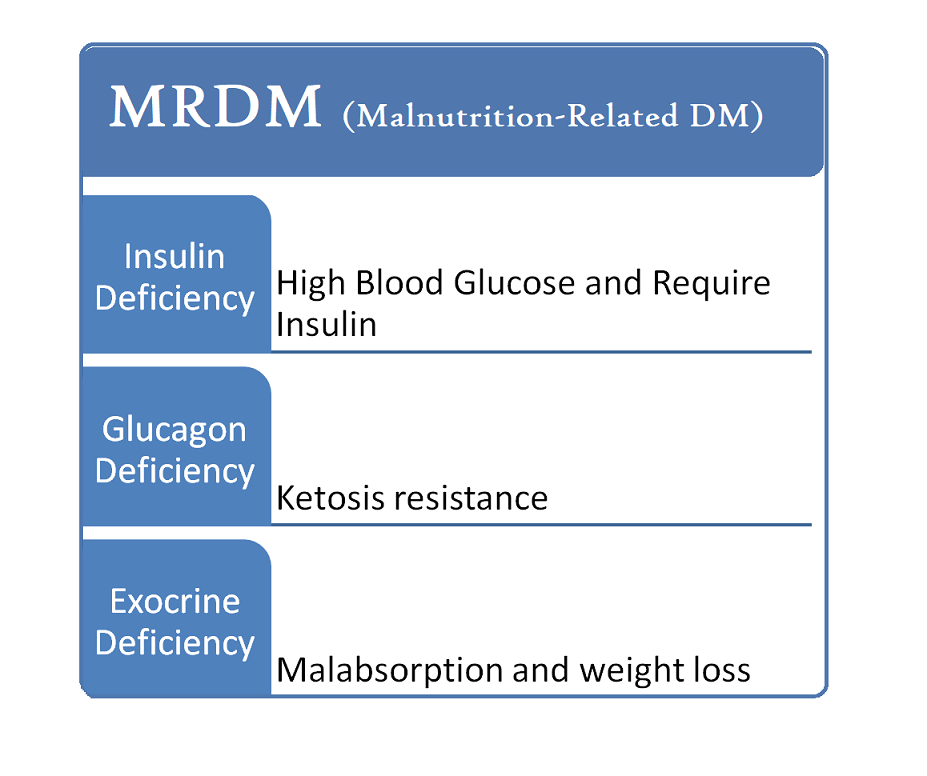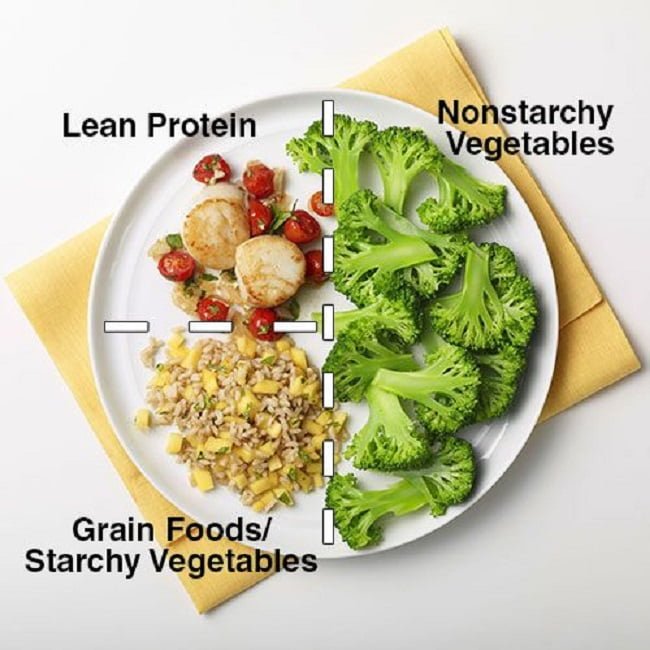MRDM or malnutrition-related diabetes mellitus is a distinct form of diabetes. It is also called “Tropical Diabetes” because of its increased prevalence in the tropics.
The characteristic feature of MRDM or malnutrition-related diabetes mellitus is that these patients have both endocrine and exocrine pancreatic insufficiency.
Endocrine deficiency results in a lack of insulin and glucagon. Thus, like type 1 DM patients, these patients have diabetes and are insulin-dependent.
However, unlike T1DM patients, they are ketosis-resistant. These patients rarely develop the acute life-threatening condition of diabetic ketoacidosis because they lack glucagon.
MRDM patients do not develop DKA
Exocrine pancreatic deficiency results in the lack of digestive pancreatic enzymes. These patients develop malabsorption, especially when they ingest frequent fatty meals.
The malabsorption of fats results in weight loss and deficiency of important fat-soluble vitamins like vitamins A, D, E, and K.
MRDM is characterized by malnutrition
While this atypical form of diabetes is mainly used to describe impaired glucose metabolism in lean patients, these patients lack the typical profile of dyslipidemia and the absence of hypertension and cardiovascular disorders as in patients with T1DM and T2DM.
These patients are mostly not completely dependent on insulin. This type of diabetes is mostly a diagnostic challenge and is often confused with the other two types.
Although this form of diabetes is uncommon, it must be properly diagnosed because an accurate diagnosis has a great impact on the prognosis and management of the disease in individual patients.
Understanding the pathophysiology of hyperglycemia aids in the effective treatment of the disease.
What causes MRDM (malnutrition-related DM)?
MRDM (Malnutrition-related diabetes mellitus) is usually found in young patients (less than 30 years of age). It is common in areas where poverty and undernutrition are prevalent.
These patients are not prone to ketosis and require a high dose of insulin to control hyperglycemia along with clinically assessed malnutrition. Most of the patients are lean even before the onset of symptoms.
MRDM is further classified into two subtypes:
- Fibrocalculous Pancreatic Diabetes Mellitus (FPDM) and
- Protein-deficient Diabetes Mellitus (PDDM). This subtype is also known as Malnutrition-modulated Diabetes Mellitus (MMDM).
It has clinical symptoms as type 1 DM but has a history of chronic childhood malnutrition. The major marker Of MRDM is the absence of ketosis despite severe hyperglycemia.

What are the symptoms of MRDM (Malnutrition-related Diabetes Mellitus):
Patients with Malnutrition-related DM commonly present with symptoms of both diabetes and malnutrition. These include the following symptoms:
- Excessive eating
- Excessive urination
- Fatigue
- Weakness
- Significant weight loss
- Recurrent abdominal pain can occur as a result of recurrent pancreatitis.
The World Health Organization (WHO) has set up a criterion for the diagnosis of MRDM. This includes:
- Blood sugar level exceeding 200mg/dl
- Less than 30 years of age
- BMI less than 19Kg/m²
- Absence of ketosis
- History of malnutrition
- Insulin Requirements of 2 IU/kg/day or more.
Diagnostic Criteria of MRDM (Malnutrition-related Diabetes Mellitus):
The diagnostic criteria include the following clinical manifestations:
S/NO. | Clinical Profile of MRDM |
| 1. | Age of onset 10–30 years |
| 2. | Leanness with a BMI less than 19 |
| 3. | History of Malnutrition in Childhood |
| 4. | The stigma of past or present Malnutrition or Deficiency state |
| 5. | Moderate to Severe Hyperglycemia |
| 6. | Lack of Proneness to ketosis in the absence of stress |
| 7. | Insulin is required to achieve metabolic control but not depend on insulin for the prevention of ketosis |
| 8. | Pancreatic calcification |
What complications may occur in patients with MRDM (Malnutrition-related Diabetes Mellitus):
Most of the cases presented with MRDM are associated with poverty and lack of resources which results in malnutrition.
Patients living in such conditions with limited resources, poor diet along marginal food availability are often not willing to take proper medical care and rather switch to herbal medications which are cheaper and often have hazardous effects on health.
This leads to improper management of hyperglycemia and lack of nutritional care which in turn leads to acute and chronic complications.
Some of the common acute complications are:
- Fungal infections.
- Pulmonary tuberculosis
- Periodontitis
- Scabies
- Hypoglycemia
Chronic complications include:
- Neuropathy (mostly painful)
- Cataracts
- Retinopathy
- Nephropathy
Management of MRDM (Malnutrition-related Diabetes Mellitus):
There are two main factors required for the management of MRDM that include Glycemic control and proper nutritional care to reverse malnutrition and help the patients achieve a healthy weight.
Glycemic control:
As far the glycemic control is concerned, the patients might need insulin therapy at first to bring the hyperglycemia under control. Hyperglycemia is usually moderate to severe.
The dosage of insulin might be greater at the start, but it is reduced gradually along with weight gain and achieving sustainable levels of glucose in the blood.
Glycemic control is the key to the management of MRDM, as it is to other forms of diabetes.
Glucose levels under control will help to prevent many acute and chronic complications and even death can occur if the hyperglycemia goes untreated for longer periods.
Controlled blood glucose levels aid in the prevention of excessive weight loss. Once the patient is out of the hyperglycemic state, diet therapy is going to show positive effects.
80% of the patients affected with MRDM require insulin for glycemic control, and only a few can be cured based on diet therapy.
MRDM (Malnutrition-related Diabetes Mellitus) Management with Diet:
Dietary intervention is usually based on a “High carbohydrate, high fiber, and low-fat diet.”
Although the dietary principles used are almost the same as those used in other types of diabetes, low BMI and malnutrition require excessive energy intake, and a balanced supply of essential amino acids (especially sulfur-containing).
Total energy must be kept between 2000-2500 kcal to meet the nutrient deficiencies
Encourage Protein-Rich Meals:
Malnourished individuals have mostly undergone muscle wasting due to which the body’s protein sources are very limited.
15-20 % of protein should be included in the diet and daily consumption should be ensured.
Rich sources of protein include meat, eggs, milk, and poultry.
People who follow a vegan diet should meet their daily protein requirements through plant-based, protein-rich foods like beans, seeds, legumes, lentils, and some vegetables.
MRDM patients are advised to increase their protein intake by routinely including meat, eggs, and milk in their daily meals.
Complex Carbohydrates and food with a low glycemic index:
Carbohydrate intake should be high so that the body’s energy requirements are fulfilled and protein breakdown is not required to supply energy to the body.
In the daily 2000 kcal, diet carbohydrates must be 55-65%. Although high carbohydrate intake is required to cover the deficiencies caused by malnutrition and to ensure a healthy weight gain, the type of carbohydrate still matters.
Patients must consume Low glycemic index foods and whole grains must be used instead of refined grains.
Whole grains prove to be very beneficial in the management of diabetes as they decrease the rate of nutrient absorption resulting in altered metabolism of glucose hence keeping the blood sugar level in normal ranges.
Fat diet: Increase Omega-3 and -6 fatty acids:

Although a low-fat diet is recommended for diabetic patients to reduce the risk of obesity, MRDM patients face severe energy deficiency.
So, 20-30% of fat is included in their diets. The fat portion must contain a greater amount of Omega-3 and Omega-6 fatty acids.
Fish is a rich source of omega-3 fatty acids, which must be included in the diet once or twice a week. Saturated fat consumption should be kept at less than 10%.
Fiber Intake:
30-40 grams of fiber must be included in the diet. This can be done by adding fruit or vegetable salads and consuming raw fruits instead of fruit juices.
With such a high intake of fiber, it is necessary to drink 8-10 glasses of water.
Water intake is increased with a high-fiber diet to avoid constipation, Fiber has a high water-holding capacity which is why inadequate water intake may result in constipation.
Malnutrition Causing Diabetes:
There is no definite proof that malnutrition is the causative factor of the disease, it can also be caused due to poor endocrine or exocrine pancreatic function.
Most patients improve satisfactorily when provided with adequate doses of insulin and a proper diet.
The protein content of such a patient’s diet is generally increased and kept to 1.5-2 g/kg/day. If muscle wasting is minimal then the protein recommendation is 1-1.5 g/kg/day.
The deficiency of vitamins and minerals is properly assessed. Supplementation of Vitamin A and D is done in patients with deficiency symptoms.
Among minerals Chromium, zinc, and selenium deficiencies have been linked to diabetes. Proper supplementation must be done in the presence of any deficiency symptoms.
Challenges in Dietary management of MRDM patients:
Poor socioeconomic status and lack of education make management a challenging problem. It is often very difficult to convince the patients to necessary treatment, regular follow-ups, and blood testing.
Poverty contributes to irregularity in treatment and many people cannot afford even small doses of insulin.
Moderate glycemic control can be achieved by providing such patients with free insulin. But, even after good glycemic control, these individuals tend to remain underweight due to poor diet.
Many of these patients are anorexic due to less availability of food and having only one meal in a day, which makes the management of MRDM more challenging. These individuals delay their visits to the hospital due to a lack of money.
When they receive proper care in the hospital, high glucose levels tend to fall and gradually become normal as the weight stabilizes. It usually takes a week or two to stabilize blood glucose levels.
Prevention of MRDM:
A lot of research still needs to be done on the causative factor of Malnutrition-related diabetes mellitus.
If malnutrition is the major cause behind this, then there is a greater need for improvement in the general nutrition and health of the population.
Recurrent pancreatitis should be avoided by treating the underlying cause. It is also important that diabetes drugs like DPP-IV inhibitors (Sitagliptin, vildagliptin) and GLP-1 analogs like Semaglutide, Liraglutide, Dulaglutide, and Mounjaro should be avoided in these patients.
These drugs may cause pancreatitis in these patients and result in more weight loss.
- 97% Pure Berberine Powder – High-purity, plant-derived extract with a rich yellow color. Carefully processed and lab-tes…
- Naturally Bitter Taste – Berberine has a strong, naturally bitter flavor. Best enjoyed when mixed with smoothies, tea, c…
- 100g in Resealable Foil Pouch – Packaged in a premium aluminum pouch to protect from moisture and light, keeping the pow…

- 5 Delicious Flavors: Freeze-Dried Mango, Freeze-Dried Blueberry, Freeze-Dried Orange, Freeze-Dried Dragon Fruit & Freeze…
- Pure and Natural Ingredients: Our fruit powders are made without synthetic pesticides, GMOs, or harmful chemicals. Each …
- Health Benefits: Our carefully selected fruits are packed with antioxidants, vitamins, fiber, and digestive enzymes to s…

- 🌿 4 Tangy Citrus Flavors in One Pack: Enjoy a delicious variety of Orange, Lime, Lemon, and Kiwi powder – 5 sachets of e…
- 💧Easy to Mix & Refreshing: Just add to water, smoothies, sparkling drinks, or tea for a vibrant citrus kick. Dissolves i…
- 🛡️Rich in Vitamin C & Antioxidants: Made from real fruit powders, this mix offers a natural source of vitamin C to suppo…

- VARIETY PACK – Includes 5 delicious organic berry powder flavors: Freeze-Dried Goji Berry, Freeze-Dried Strawberry, Free…
- PURE INGREDIENTS – Made with 100% natural, freeze-dried berries and absolutely no added sugar, artificial ingredients, o…
- CONVENIENT PACKAGING – Contains 20 pre-portioned 5g packets (100g total), eliminating the need for measuring and ensurin…









